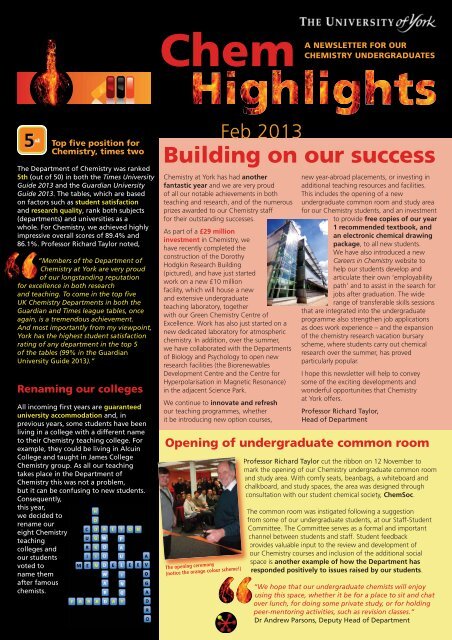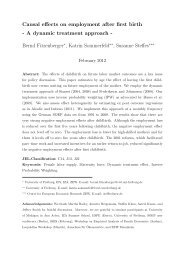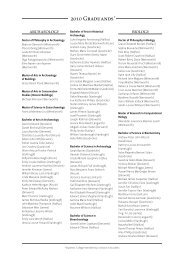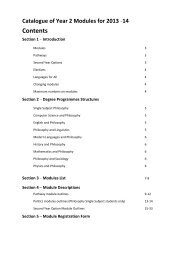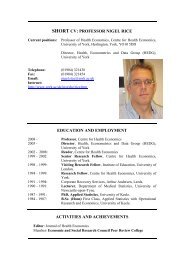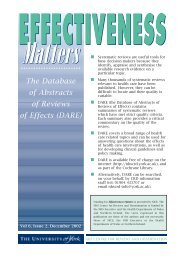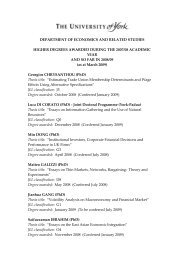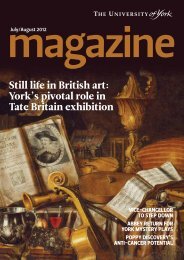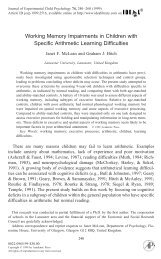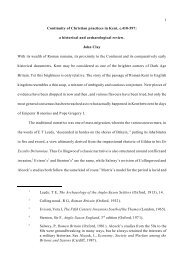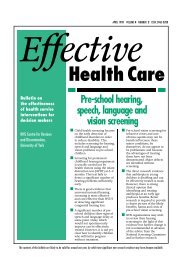05-13 Chem Highlights AMEND:Chem news - University of York
05-13 Chem Highlights AMEND:Chem news - University of York
05-13 Chem Highlights AMEND:Chem news - University of York
You also want an ePaper? Increase the reach of your titles
YUMPU automatically turns print PDFs into web optimized ePapers that Google loves.
<strong>Chem</strong><br />
A NEWSLETTER FOR OUR<br />
CHEMISTRY UNDERGRADUATES<br />
Top five position for<br />
<strong>Chem</strong>istry, times two<br />
The Department <strong>of</strong> <strong>Chem</strong>istry was ranked<br />
5th (out <strong>of</strong> 50) in both the Times <strong>University</strong><br />
Guide 20<strong>13</strong> and the Guardian <strong>University</strong><br />
Guide 20<strong>13</strong>. The tables, which are based<br />
on factors such as student satisfaction<br />
and research quality, rank both subjects<br />
(departments) and universities as a<br />
whole. For <strong>Chem</strong>istry, we achieved highly<br />
impressive overall scores <strong>of</strong> 89.4% and<br />
86.1%. Pr<strong>of</strong>essor Richard Taylor noted,<br />
“Members <strong>of</strong> the Department <strong>of</strong><br />
<strong>Chem</strong>istry at <strong>York</strong> are very proud<br />
<strong>of</strong> our longstanding reputation<br />
for excellence in both research<br />
and teaching. To come in the top five<br />
UK <strong>Chem</strong>istry Departments in both the<br />
Guardian and Times league tables, once<br />
again, is a tremendous achievement.<br />
And most importantly from my viewpoint,<br />
<strong>York</strong> has the highest student satisfaction<br />
rating <strong>of</strong> any department in the top 5<br />
<strong>of</strong> the tables (99% in the Guardian<br />
<strong>University</strong> Guide 20<strong>13</strong>).”<br />
Renaming our colleges<br />
All incoming first years are guaranteed<br />
university accommodation and, in<br />
previous years, some students have been<br />
living in a college with a different name<br />
to their <strong>Chem</strong>istry teaching college. For<br />
example, they could be living in Alcuin<br />
College and taught in James College<br />
<strong>Chem</strong>istry group. As all our teaching<br />
takes place in the Department <strong>of</strong><br />
<strong>Chem</strong>istry this was not a problem,<br />
but it can be confusing to new students.<br />
Consequently,<br />
this year,<br />
we decided to<br />
rename our<br />
eight <strong>Chem</strong>istry<br />
teaching<br />
colleges and<br />
our students<br />
voted to<br />
name them<br />
after famous<br />
chemists.<br />
Feb 20<strong>13</strong><br />
Building on our success<br />
<strong>Chem</strong>istry at <strong>York</strong> has had another<br />
fantastic year and we are very proud<br />
<strong>of</strong> all our notable achievements in both<br />
teaching and research, and <strong>of</strong> the numerous<br />
prizes awarded to our <strong>Chem</strong>istry staff<br />
for their outstanding successes.<br />
As part <strong>of</strong> a £29 million<br />
investment in <strong>Chem</strong>istry, we<br />
have recently completed the<br />
construction <strong>of</strong> the Dorothy<br />
Hodgkin Research Building<br />
(pictured), and have just started<br />
work on a new £10 million<br />
facility, which will house a new<br />
and extensive undergraduate<br />
teaching laboratory, together<br />
with our Green <strong>Chem</strong>istry Centre <strong>of</strong><br />
Excellence. Work has also just started on a<br />
new dedicated laboratory for atmospheric<br />
chemistry. In addition, over the summer,<br />
we have collaborated with the Departments<br />
<strong>of</strong> Biology and Psychology to open new<br />
research facilities (the Biorenewables<br />
Development Centre and the Centre for<br />
Hyperpolarisation in Magnetic Resonance)<br />
in the adjacent Science Park.<br />
We continue to innovate and refresh<br />
our teaching programmes, whether<br />
it be introducing new option courses,<br />
new year-abroad placements, or investing in<br />
additional teaching resources and facilities.<br />
This includes the opening <strong>of</strong> a new<br />
undergraduate common room and study area<br />
for our <strong>Chem</strong>istry students, and an investment<br />
to provide free copies <strong>of</strong> our year<br />
1 recommended textbook, and<br />
an electronic chemical drawing<br />
package, to all new students.<br />
We have also introduced a new<br />
Careers in <strong>Chem</strong>istry website to<br />
help our students develop and<br />
articulate their own ‘employability<br />
path’ and to assist in the search for<br />
jobs after graduation. The wide<br />
range <strong>of</strong> transferable skills sessions<br />
that are integrated into the undergraduate<br />
programme also strengthen job applications<br />
as does work experience – and the expansion<br />
<strong>of</strong> the chemistry research vacation bursary<br />
scheme, where students carry out chemical<br />
research over the summer, has proved<br />
particularly popular.<br />
I hope this <strong>news</strong>letter will help to convey<br />
some <strong>of</strong> the exciting developments and<br />
wonderful opportunities that <strong>Chem</strong>istry<br />
at <strong>York</strong> <strong>of</strong>fers.<br />
Pr<strong>of</strong>essor Richard Taylor,<br />
Head <strong>of</strong> Department<br />
Opening <strong>of</strong> undergraduate common room<br />
The opening ceremony<br />
(notice the orange colour scheme!)<br />
Pr<strong>of</strong>essor Richard Taylor cut the ribbon on 12 November to<br />
mark the opening <strong>of</strong> our <strong>Chem</strong>istry undergraduate common room<br />
and study area. With comfy seats, beanbags, a whiteboard and<br />
chalkboard, and study spaces, the area was designed through<br />
consultation with our student chemical society, <strong>Chem</strong>Soc.<br />
The common room was instigated following a suggestion<br />
from some <strong>of</strong> our undergraduate students, at our Staff-Student<br />
Committee. The Committee serves as a formal and important<br />
channel between students and staff. Student feedback<br />
provides valuable input to the review and development <strong>of</strong><br />
our <strong>Chem</strong>istry courses and inclusion <strong>of</strong> the additional social<br />
space is another example <strong>of</strong> how the Department has<br />
responded positively to issues raised by our students.<br />
“We hope that our undergraduate chemists will enjoy<br />
using this space, whether it be for a place to sit and chat<br />
over lunch, for doing some private study, or for holding<br />
peer-mentoring activities, such as revision classes.”<br />
Dr Andrew Parsons, Deputy Head <strong>of</strong> Department
Student<br />
feedback<br />
Feedback from our<br />
students plays an<br />
important role in helping<br />
us to improve our<br />
teaching and the student<br />
experience. We seek feedback in different<br />
ways, from representation <strong>of</strong> students on<br />
various departmental committees, to<br />
completion <strong>of</strong> online feedback forms, to<br />
informal discussions with members <strong>of</strong><br />
staff. Academic staff review the feedback<br />
and for every course a report is compiled,<br />
summarising what feedback was obtained<br />
and any actions to be undertaken. This<br />
year, as well as providing the reports<br />
online, we have displayed them in the<br />
department for all to see.<br />
“Overall I think the Department<br />
<strong>of</strong> <strong>Chem</strong>istry is brilliant. Topics<br />
are interesting and well taught.<br />
I’m very glad to be studying here.”<br />
Quote from a current student<br />
Best department<br />
for supervision<br />
The Department was awarded the highly<br />
competitive ‘Best Department’ prize<br />
at the ‘Supervisor <strong>of</strong> the Year’ awards<br />
organised by <strong>York</strong> <strong>University</strong> Students’<br />
Union (YUSU). Students across the<br />
university were able to nominate their<br />
personal supervisors for an award,<br />
and based on the number and quality<br />
<strong>of</strong> nominations, the awarding panel<br />
recognised the whole <strong>Chem</strong>istry<br />
department as providing the very<br />
best supervision <strong>of</strong> its undergraduate<br />
students. This reflects the results <strong>of</strong> the<br />
2011 National Student Survey in which<br />
93% <strong>of</strong> <strong>York</strong> <strong>Chem</strong>istry students felt they<br />
received good advice and support with<br />
their studies. Our pastoral supervision <strong>of</strong><br />
students is supported by our small group<br />
teaching system based on chemistry<br />
colleges, which allows students to<br />
build their chemistry knowledge in a<br />
supportive environment, and develop<br />
an excellent understanding with their<br />
college tutors.<br />
Nominated chemistry supervisors<br />
<strong>Chem</strong>istry@<strong>York</strong> February 20<strong>13</strong><br />
Research<br />
<strong>Highlights</strong><br />
<strong>York</strong> insulin chemists in<br />
anniversary breakthrough<br />
<strong>Chem</strong>ists in our YSBL group are part<br />
<strong>of</strong> an international team that has<br />
established the first three-dimensional<br />
insight into the complex way the<br />
insulin hormone binds to its receptor<br />
on cell surfaces. The study is published<br />
in the journal Nature, 90 years after<br />
the discovery <strong>of</strong> insulin, and 43 years<br />
after determination <strong>of</strong> the crystal<br />
structure <strong>of</strong> the hormone by Dorothy<br />
Hodgkin. This first demonstration<br />
<strong>of</strong> insulin/insulin-receptor<br />
interaction will potentially assist<br />
insulin modification to develop more<br />
effective hormone therapies for<br />
treating diabetes, a disease that is a<br />
growing burden in both developed<br />
and developing societies.<br />
‘Mining’ for metals<br />
using Nature’s machines<br />
Researchers in the <strong>University</strong>’s Green<br />
<strong>Chem</strong>istry Centre <strong>of</strong> Excellence and the<br />
Centre for Novel Agricultural Products<br />
(CNAP) aim to develop ways to extract<br />
platinum group metals (PGM) discarded<br />
during mine processing which might then<br />
be used in catalysis. The research will<br />
investigate “phyto-mining”, which<br />
involves growing plants on mine waste<br />
materials to sponge up PGM into their<br />
cellular structure. Initial studies show that<br />
plant cells used to phyto-mine PGM can<br />
be turned into materials for a variety <strong>of</strong><br />
industrial applications – the one in most<br />
demand being catalytic converters for<br />
vehicle emissions control.<br />
New study reveals gas that<br />
triggers ozone destruction<br />
<strong>Chem</strong>ists at <strong>York</strong> and Leeds have made a<br />
significant discovery about the cause<br />
<strong>of</strong> the destruction <strong>of</strong> ozone over oceans.<br />
They have established that the majority<br />
<strong>of</strong> ozone-depleting iodine oxide<br />
observed over the remote ocean comes<br />
from a previously unknown marine<br />
source. The research team found that<br />
the principal source <strong>of</strong> iodine oxide<br />
can be explained by emissions <strong>of</strong><br />
hypoiodous acid (HOI) – a gas not yet<br />
considered as being released from the<br />
ocean – along with a contribution from<br />
molecular iodine (I 2 ). This new research,<br />
which is published in Nature Geoscience,<br />
builds on an earlier study which showed<br />
that reactive iodine, along with bromine,<br />
in the atmosphere is responsible for the<br />
destruction <strong>of</strong> vast amounts <strong>of</strong> ozone –<br />
around 50 per cent more than predicted<br />
by the world’s most advanced climate<br />
models – in the lower atmosphere over<br />
the tropical Atlantic Ocean.<br />
New partnership to ‘accelerate’ evaluation <strong>of</strong> chemical reactions<br />
The Department has agreed a new partnership with a Swiss-based technology company<br />
to modernise the way chemical reactions are screened and evaluated. Under the new<br />
partnership with <strong>Chem</strong>speed Technologies, the company will invest £750,000 to provide<br />
two robotic platforms to be housed in our Dorothy Hodgkin research building.<br />
“Accelerating the speed and increasing the number <strong>of</strong> experiments<br />
is a critical factor in research and development. The higher output,<br />
especially testing a greater number <strong>of</strong> experimental variables, can<br />
leverage the success rate in finding new, greener and cleaner synthetic<br />
methods which are important drivers in research, not only for<br />
academics but also in industry.” Pr<strong>of</strong>essor Ian Fairlamb<br />
Collagen damage<br />
on a molecular scale<br />
A team <strong>of</strong> mathematicians, chemists<br />
and archaeologists at <strong>York</strong> have<br />
come up with a new way to analyse<br />
old bones using mass-spectrometric<br />
methods. The new approach,<br />
developed by Dr Julie Wilson, enables<br />
the rapid assessment <strong>of</strong> damage in<br />
bone collagen at the scale <strong>of</strong> single<br />
amino acids. Using this technique the<br />
team mapped a large number <strong>of</strong><br />
archaeological bones, revealing that<br />
different residues degrade at different<br />
rates. Excitingly, this method could be<br />
able to date artifacts as old as<br />
1,000,000 years, which is well<br />
beyond that possible for carbon dating.<br />
www.york.ac.uk/<strong>Chem</strong>istry
<strong>Chem</strong>istry@<strong>York</strong> February 20<strong>13</strong><br />
Opening <strong>of</strong> the second phase <strong>of</strong> the Dorothy Hodgkin Building<br />
A new £9.4 million second phase to a key research<br />
building – the latest stage in a major re-development<br />
programme in the Department <strong>of</strong> <strong>Chem</strong>istry – was<br />
opened <strong>of</strong>ficially on 31 October. The first phase<br />
was completed in August 2004.<br />
Underscoring <strong>York</strong>’s enduring link with one <strong>of</strong> the UK’s<br />
outstanding scientists <strong>of</strong> the 20th century, the new<br />
facilities were opened by Pr<strong>of</strong>essor Michael Grätzel, the<br />
Director <strong>of</strong> the Laboratory <strong>of</strong> Photonics and Interfaces<br />
at the École Polytechnique Fédérale de Lausanne in<br />
Switzerland. Before opening the building, Pr<strong>of</strong>essor<br />
Michael Grätzel gave a public lecture entitled ‘Power<br />
from the Sun, solar cells that mimic photosynthesis’.<br />
The Vice-Chancellor, Pr<strong>of</strong>essor Brian Cantor, said:<br />
“We take great pride in our association with Dorothy Hodgkin. This exciting<br />
research building, named after her, reflects our commitment to <strong>Chem</strong>istry<br />
in <strong>York</strong>. These excellent new facilities will help our talented researchers to<br />
continue their world-leading research and to make discoveries that make a tangible<br />
difference to society.”<br />
The building is constructed on the site <strong>of</strong> the laboratory where, in her retirement in the<br />
1970s and 1980s, Pr<strong>of</strong>essor Hodgkin wrote up the findings <strong>of</strong> a total <strong>of</strong> more than 30 years’<br />
research into insulin structures carried out principally in Oxford.<br />
For photos taken during the construction:<br />
http://www.york.ac.uk/campus-development/projects/chemistry-e/chemistry/<br />
Biorenewables<br />
Development Centre<br />
– open for business<br />
The Biorenewables Development Centre<br />
(BDC) was <strong>of</strong>ficially opened by the<br />
Rt Hon Dr Vince Cable MP, Secretary<br />
<strong>of</strong> State for Business, Industry and Skills,<br />
on 5 July 2012.<br />
The BDC is a 10–100 kg (10–100 litres)<br />
world-class scale-up facility that allows<br />
<strong>York</strong> researchers to test the most<br />
promising processes for converting<br />
renewables into chemicals and<br />
materials. In this way they can prove<br />
a new process and/or produce enough<br />
product for detailed commercial analysis<br />
and assessment, for example by an<br />
interested company. The BDC is very<br />
much about engaging and working with<br />
industry and is a joint venture between<br />
the Departments <strong>of</strong> <strong>Chem</strong>istry (Green<br />
<strong>Chem</strong>istry) and Biology (CNAP), which<br />
is funded by the ERDF and BIS.<br />
For a video ‘flythrough’:<br />
http://www.youtube.com/watchv=k0ouVH-<br />
_sn0&feature=player_embedded<br />
New <strong>Chem</strong>ical Structures<br />
New atmospheric building<br />
The Department is developing the first<br />
dedicated laboratory building in the UK<br />
for atmospheric chemistry research.<br />
Supported in part by a £1.25M grant<br />
from the Wolfson Foundation, the<br />
facility will co-locate state-<strong>of</strong>-the-art<br />
global computer modelling facilities<br />
with laboratory science and instrument<br />
technology development plus<br />
calibration and logistics support for<br />
field observations. The Wolfson lab<br />
will bring together the atmospheric<br />
research teams in <strong>Chem</strong>istry as well as<br />
providing experimental and modelling<br />
infrastructure for interdisciplinary<br />
research across the <strong>University</strong>.<br />
Opening <strong>of</strong> refurbished teaching laboratory<br />
The Department has worked closely with the <strong>University</strong> to remodel and refurbish<br />
part <strong>of</strong> our undergraduate teaching laboratories – one <strong>of</strong> the four lobes <strong>of</strong> teaching<br />
laboratories, an instrument room and a chemical preparation room. All <strong>of</strong> the work<br />
was completed in time for the start <strong>of</strong> the 2012–<strong>13</strong> academic year.<br />
All areas are equipped with high quality<br />
fumehoods and laboratory furniture,<br />
and there has been a significant<br />
investment in the latest equipment.<br />
Around £150k has been invested in<br />
new state-<strong>of</strong>-the-art instrumentation,<br />
including infrared spectrometers and<br />
fluorospectrophotometers, together with<br />
£120k in new glassware and equipment.<br />
The refurbishment has also incorporated aspects <strong>of</strong> modern building design, including<br />
numerous ro<strong>of</strong> light domes, which has allowed natural light to flood into the lab,<br />
giving it a very light and open feel. Pr<strong>of</strong>essor Richard Taylor noted:<br />
“The refurbished labs will be superb to work in – and now that the<br />
construction <strong>of</strong> the new teaching labs has started, the new first year<br />
undergraduates will be the envy <strong>of</strong> students everywhere!”<br />
Looking at demolition and rebuilding<br />
The building will house faculty staff,<br />
post-doctoral researchers, external<br />
research staff including those from the<br />
National Centre for Atmospheric Science<br />
and Defra, as well as postgraduates<br />
and undergraduates undertaking<br />
research projects.<br />
To prepare for our new undergraduate teaching<br />
laboratory and Green <strong>Chem</strong>istry Centre <strong>of</strong> Excellence<br />
we have recently demolished an older research building<br />
– you may like to see our short video showing the<br />
demolition works: http://www.york.ac.uk/chemistry/newbuild/<br />
You can also check out the progress <strong>of</strong> our new<br />
building project, recorded using a webcam:<br />
http://www.york.ac.uk/ chemistry/images/cam/index1.cfm
Undergraduate <strong>Chem</strong>istry<br />
degrees accredited<br />
The Department is delighted to announce that<br />
all <strong>of</strong> its undergraduate degree courses have<br />
recently been re-accredited by the<br />
Royal Society <strong>of</strong> <strong>Chem</strong>istry (RSC).<br />
This means that all <strong>of</strong> our BSc and<br />
M<strong>Chem</strong> degrees are recognised by<br />
the RSC as providing high quality<br />
training and skills in <strong>Chem</strong>istry. <strong>York</strong> <strong>Chem</strong>istry<br />
is one <strong>of</strong> the very first departments in the UK<br />
to have its BSc degree accredited by the RSC.<br />
As part <strong>of</strong> the accreditation process,<br />
independent experts carefully scrutinised<br />
our degree programmes. They praised our<br />
‘integrated approach to chemical science<br />
teaching and learning’ and ‘high quality<br />
problem solving experience’ delivered by<br />
a ‘strong cohort <strong>of</strong> staff’ and the ‘good<br />
range <strong>of</strong> both traditional and modern<br />
experiments’, which our students carry<br />
out in teaching laboratories. The Department<br />
was particularly commended for its varied<br />
programme to help students develop<br />
transferable skills, which was considered<br />
‘excellent’, and ‘<strong>of</strong>ten achieved in<br />
a unique way’.<br />
“The tutorials are always fantastic,<br />
the small group set up means<br />
you can really develop your<br />
understanding and connect with<br />
what your tutor is telling you.”<br />
Quote from a current student<br />
<strong>Chem</strong>istry@<strong>York</strong> February 20<strong>13</strong><br />
New <strong>Chem</strong>istry<br />
course pages for KIS<br />
To prepare our website for the introduction<br />
<strong>of</strong> Key Information Sets (KIS), we recently<br />
revamped the web information for all<br />
16 <strong>of</strong> our <strong>Chem</strong>istry degree programmes.<br />
KIS has been designed to meet the<br />
information needs <strong>of</strong> prospective students<br />
trying to compare different courses<br />
from different Institutions.<br />
For all <strong>of</strong> our 3-year BSc and 4-year<br />
M<strong>Chem</strong> <strong>Chem</strong>istry degree programmes<br />
we now have separate web pages, with<br />
specific and detailed information<br />
in each <strong>of</strong> the following areas:<br />
¬ Overview ¬ Course content<br />
¬ Teaching ¬ Assessment<br />
¬ Careers ¬ Applying<br />
Teaching<br />
Prominence<br />
Teaching Award for<br />
Nigel Lowe<br />
Congratulations to Dr Nigel Lowe<br />
who was awarded a Vice-Chancellor’s<br />
Teaching Award for 2012. Nigel is the<br />
fifth member <strong>of</strong> the Department <strong>of</strong><br />
<strong>Chem</strong>istry to win an individual<br />
award, which recognises and<br />
rewards excellence in teaching<br />
at <strong>York</strong>.<br />
The awards panel commended Nigel on<br />
his innovative approaches to transferable<br />
skills teaching across the Department,<br />
and his use <strong>of</strong> e-learning to support<br />
practical <strong>Chem</strong>istry. They were also<br />
impressed by his engagement with<br />
the UK chemical education community<br />
through publications and<br />
collaborative projects.<br />
“The feedback I received<br />
on the practical course<br />
was very constructive.”<br />
Quote from a current student<br />
David Smith nominated for<br />
THE ‘Most Innovative Teacher’<br />
Stepping up to chemistry<br />
‘Stepping up to <strong>Chem</strong>istry’ is a web resource aimed at preuniversity<br />
students, prior to starting their course here at <strong>York</strong>.<br />
Developed in collaboration with our students, this material<br />
is designed to help students with topics that are generally<br />
found to be the most difficult (based on student feedback)<br />
and to ease the transition to university. We also hope it<br />
will prove useful to our students during their first year <strong>of</strong> study.<br />
Topics include quantitative chemistry, laboratory practicals,<br />
atoms, ions and quanta, and energetics. For each topic, alongside an introduction,<br />
there are sections that include a summary <strong>of</strong> key points, useful texts and web resources,<br />
worked examples, and practice problems with outline answers, including video clips<br />
showing walkthroughs <strong>of</strong> selected answers.<br />
We thank our students who helped develop this project, in particular, Katie Lee who<br />
instigated the project and Elizabeth Wilcock who expanded the material and added<br />
it to the web. Katie developed the material as part <strong>of</strong> a project in the third year <strong>of</strong> her<br />
BSc degree, while Elizabeth was awarded a student internship to develop the project<br />
over the summer between the second and third year <strong>of</strong> her <strong>Chem</strong>istry degree.<br />
Pr<strong>of</strong>essor David Smith was nominated for<br />
a Times Higher Education Award as ‘Most<br />
Innovative Teacher’. This nomination<br />
recognises Dave’s novel approaches to<br />
student teaching over a number <strong>of</strong> years<br />
and in particular his recent innovations<br />
in the use <strong>of</strong> YouTube, in a project called<br />
‘ITube, YouTube, WeTube, <strong>Chem</strong>Tube’.<br />
Dave has developed a YouTube channel<br />
(http://www.YouTube.com/pr<strong>of</strong>essordaveatyork)<br />
that aims to explain the organic<br />
chemistry <strong>of</strong> everyday life. He has also<br />
enabled <strong>York</strong> undergraduates to engage<br />
with making their own YouTube videos as<br />
part <strong>of</strong> the assessment for their first year<br />
Macromolecules course. In this way, the<br />
students themselves go on to inspire the<br />
next generation <strong>of</strong> learners around the<br />
world. Playlists <strong>of</strong> these student videos<br />
can also be found in Dave’s YouTube<br />
channel.<br />
New appointment<br />
We are delighted to announce that Dr Alison Parkin joined the department as an<br />
Anniversary Research Lecturer in October. Alison’s research explores how transition<br />
metal centres in proteins activate chemical reactions that are essential for life.<br />
“I am having an exciting time as a new member <strong>of</strong> academic staff.<br />
The whole department has been extremely welcoming and it is<br />
brilliant to share chemistry ideas and challenges with an inspiring<br />
group <strong>of</strong> research colleagues and enthusiastic undergraduate students.”<br />
www.york.ac.uk/<strong>Chem</strong>istry<br />
One <strong>of</strong> our students, Will Ingram, introduces inorganic<br />
polymers on his YouTube video
2012 research<br />
award winners<br />
Dr Fred Antson<br />
Senior Research Fellowship<br />
Wellcome Trust<br />
Pr<strong>of</strong> Gideon Davies<br />
European Research Council<br />
Advanced Grant<br />
Pr<strong>of</strong> Pratibha Gai<br />
Laureate for Europe<br />
L’OREAL-UNESCO<br />
Women in Science Awards<br />
Pr<strong>of</strong> Ally Lewis<br />
Royal Society <strong>of</strong> <strong>Chem</strong>istry<br />
John Jeyes Award<br />
Dr Kirsty Penkman<br />
Philip Leverhulme Prize<br />
The Leverhulme Trust<br />
Pr<strong>of</strong> David Smith<br />
Royal Society <strong>of</strong> <strong>Chem</strong>istry<br />
Corday-Morgan Prize<br />
Pr<strong>of</strong> Richard Taylor<br />
Royal Society <strong>of</strong> <strong>Chem</strong>istry<br />
RSC Natural Product<br />
<strong>Chem</strong>istry Award<br />
Cantor Nanoscience Lecture<br />
given by Nobel Laureate<br />
On 25 May, Dr Venki Ramakrishnan,<br />
(Nobel Laureate and MRC Laboratory<br />
<strong>of</strong> Molecular Biology, Cambridge) gave<br />
the Cantor Nanoscience lecture: How<br />
antibiotics illuminate ribosome function<br />
and vice versa. In 2000, his laboratory<br />
determined the atomic structure <strong>of</strong> the<br />
30S ribosomal subunit and its complexes<br />
with ligands and antibiotics. This work<br />
has led to insights into how the ribosome<br />
‘reads’ the genetic code, as well as into<br />
various aspects <strong>of</strong> antibiotic function.<br />
For this work, he shared the 2009<br />
Nobel Prize in <strong>Chem</strong>istry.<br />
After the lecture, the Vice Chancellor<br />
awarded a book prize to 3 students who<br />
had performed particularly well in their<br />
first year; Edward Matthews received<br />
the <strong>Chem</strong>istry prize (pictured below).<br />
<strong>Chem</strong> <strong>Highlights</strong> Feb 20<strong>13</strong><br />
Research Funding<br />
<strong>Chem</strong>ists Awarded<br />
£800k EPSRC grant<br />
Pr<strong>of</strong>essors Simon Duckett and<br />
Robin Perutz were recently awarded<br />
an Engineering and Physical Sciences<br />
Research Council (EPSRC) grant worth<br />
£800,000. The grant, entitled “Reaction<br />
monitoring on micro-second timescales<br />
by nuclear magnetic resonance: aiming<br />
for a paradigm shift in the study <strong>of</strong><br />
reaction mechanisms”, will start<br />
in early 20<strong>13</strong> and run for 4 years.<br />
New scanning technology aims to achieve<br />
quicker diagnosis <strong>of</strong> disease<br />
<strong>York</strong> chemist awarded<br />
£480K for s<strong>of</strong>t materials<br />
research<br />
Pr<strong>of</strong>essor David Smith has been<br />
awarded €575,000 as part <strong>of</strong> the<br />
€4.1 million EU-funded network<br />
SMART-NET (S<strong>of</strong>t Materials Advanced<br />
Research and Training Network).<br />
Over the next four years, this network<br />
will support the training <strong>of</strong> 12<br />
PhD students across a network<br />
<strong>of</strong> six universities from the UK,<br />
Netherlands, France, Spain and Italy,<br />
and 3 postdoctoral researchers<br />
based in partner companies and<br />
government agencies.<br />
<strong>York</strong> chemist awarded<br />
£1.8M from MRC<br />
Dr Marek Brzozowski, from our YSBL<br />
group, has been awarded £1.8M from<br />
the Medical Research Council (MRC)<br />
to investigate the interplay between<br />
diabetes and cancer. This is an<br />
interdisciplinary and international<br />
programme that targets the key<br />
molecular contacts at the insulin<br />
receptor complex. The programme<br />
has a two-tier approach combining<br />
fundamental and applied research.<br />
In the very long term, it is envisaged<br />
that the research will be relevant<br />
to experimental and even clinical<br />
intervention <strong>of</strong> both metabolic and<br />
mitogenic (cancer-related) pathways.<br />
Pr<strong>of</strong>essor Simon Duckett is working on new technology that could revolutionise the<br />
way in which Magnetic Resonance Imaging (MRI) scans are used to view the molecular<br />
events behind diseases like Alzheimer’s, without invasive procedure, by increasing<br />
the sensitivity <strong>of</strong> an average hospital scanner by 200,000 times. The technology<br />
underpinning this project, SABRE (Signal Amplification by Reversible Exchange), has<br />
received a £3.6M Strategic Award from the Wellcome Trust. The new grant brings<br />
the total support for SABRE from the Wellcome Trust, the Wolfson Foundation,<br />
Bruker Biospin, the <strong>University</strong> <strong>of</strong> <strong>York</strong> and the Engineering and Physical Sciences<br />
Research Council (EPSRC) to over £12.5M in the last three years.<br />
http://www.york.ac.uk/<strong>news</strong>-and-events/features/hyperpolarisation/<br />
<strong>Chem</strong>ists awarded a<br />
€2.3 million research grant<br />
Pr<strong>of</strong>essors Gideon Davies and<br />
Paul Walton have been awarded a<br />
€2.3 million research grant from the<br />
European Research Agency-Industrial<br />
Biotechnology initiative. The project,<br />
which is led from <strong>York</strong>, has partners in<br />
Copenhagen, Marseille and Cambridge.<br />
It aims to bring together expertise in<br />
molecular biology, inorganic chemistry,<br />
genomics, analysis and industry to<br />
explore the significant opportunities for<br />
bioethanol production created by the<br />
recent discovery <strong>of</strong> GH61 enzymes.<br />
A spacefilling<br />
model <strong>of</strong><br />
ethanol<br />
www.york.ac.uk/<strong>Chem</strong>istry
<strong>Chem</strong> <strong>Highlights</strong> Feb 20<strong>13</strong><br />
NEW advanced organic synthesis option<br />
As part <strong>of</strong> a continuing commitment to refresh and revise our<br />
undergraduate degree programmes, we have recently introduced a<br />
new third year option called Advanced Synthesis – From Nature to<br />
the Lab. First, the module outlines how biological systems achieve<br />
the synthesis <strong>of</strong> complex natural products. Advanced retrosynthesis<br />
is then covered, followed by aspects <strong>of</strong> stereoselective synthesis, and<br />
finally, approaches to prepare nitrogen-containing functional groups<br />
present in pharmaceuticals and agrochemicals. January saw the launch <strong>of</strong> this new<br />
module which has proven to be extremely popular, with nearly 90 students on the course.<br />
It is led by Peter O’Brien, one <strong>of</strong> our organic chemistry pr<strong>of</strong>essors, who says:<br />
“This is a fantastic and exciting addition to our organic chemistry teaching,<br />
focusing on how complex molecules are synthesised. It is ideal preparation<br />
for students who are planning a<br />
4th year in the pharmaceutical industry.”<br />
Short-listed for<br />
Outstanding Departmental<br />
Administration Team<br />
The National Student Survey (NSS)<br />
runs until the end <strong>of</strong> April 20<strong>13</strong> and we<br />
encourage all chemists in the final year<br />
<strong>of</strong> their course to complete the survey.<br />
This year the Student Hardship fund will<br />
receive £1 for every survey completed.<br />
The <strong>University</strong> <strong>of</strong> <strong>York</strong> has an<br />
outstanding reputation for teaching<br />
and research, featuring consistently in<br />
the top few places in the league tables<br />
<strong>of</strong> UK universities, and we hope that<br />
this continues for next year.<br />
Following on from last year’s NSS we<br />
will be improving the way we inform<br />
students <strong>of</strong> our actions to their<br />
feedback. This includes asking module<br />
coordinators to detail the changes to<br />
a given course on the basis <strong>of</strong> student<br />
feedback and this information will<br />
be published (e.g. on a noticeboard<br />
and/or online).<br />
Record breaking placements<br />
This summer, a record<br />
number <strong>of</strong> over 50 <strong>of</strong><br />
our students will be<br />
spending a Year in<br />
Industry. The <strong>Chem</strong>ical<br />
Industry seems to<br />
appreciate the extra<br />
maturity and the enhanced background<br />
in <strong>Chem</strong>istry shown by our Year 4 students.<br />
Dr Brian Grievson, our year in<br />
industry co-ordinator noted: “The<br />
future <strong>of</strong> our M<strong>Chem</strong>(Industry)<br />
scheme looks very healthy,<br />
which is fantastic <strong>news</strong> for students<br />
considering <strong>York</strong> as a place to study.”<br />
The Department <strong>of</strong> <strong>Chem</strong>istry Administration<br />
Team were shortlisted for the Outstanding<br />
Departmental Administration Team at the<br />
Times Higher Education (THE) Leadership<br />
and Management Awards 2012. The team<br />
were short-listed for their exceptional<br />
communication, co-operation and strong<br />
team spirit, which underpin all the activities<br />
within the Department. In 2012, the team<br />
brought in innovative procedures and<br />
processes to provide examples <strong>of</strong> best<br />
practice across the <strong>University</strong> and HE sector,<br />
with many innovations being adopted<br />
by other departments.<br />
Pr<strong>of</strong>essor Brian Fulton, Academic<br />
Coordinator for the Sciences, says:<br />
“The <strong>Chem</strong>istry Admin team are<br />
known throughout the <strong>University</strong><br />
for their pr<strong>of</strong>essionalism, attention<br />
to detail and innovative practices, and<br />
a key part <strong>of</strong> operating such a large<br />
and vibrant Department.”<br />
<strong>York</strong> Graduation July 20<strong>13</strong><br />
The <strong>Chem</strong>istry Graduation Ceremony<br />
will be held on Wednesday 10 July 20<strong>13</strong><br />
at 3.30pm.<br />
50 years <strong>of</strong> changing the world<br />
Follow the QR code<br />
for a reflection on<br />
the <strong>University</strong>’s<br />
first 5 decades. See<br />
photos <strong>of</strong> student<br />
life in the 1960s!<br />
Useful Links:<br />
The Careers Service<br />
www.york.ac.uk/services/careers/index.cfm<br />
The Careers Service is for all <strong>University</strong><br />
<strong>of</strong> <strong>York</strong> students (undergraduates and<br />
postgraduates <strong>of</strong> all years and subjects<br />
<strong>of</strong> study) and graduates. This service<br />
can help our students think about<br />
their future career, with advice and<br />
information about the options open<br />
to them. For example, current students<br />
can attend recruitment events and<br />
workshops on aspects <strong>of</strong> job search,<br />
whereas recent graduates can access<br />
individual careers guidance interviews.<br />
The Careers Service is on Facebook:<br />
www.facebook.com/yorkcareersv=info:<br />
<strong>Chem</strong>istry Alumni<br />
www.york.ac.uk/chemistry/alumni/<br />
Following graduation, the Department<br />
is very keen to keep in touch with its<br />
former students. We’d like to hear about<br />
their employment <strong>news</strong>, job changes,<br />
personal achievements, life changes<br />
and any other <strong>news</strong> that they may have.<br />
Our alumni can interact with us in<br />
a variety <strong>of</strong> ways, including attending<br />
our research seminars or Open Days,<br />
talking about their careers to our<br />
undergraduate students at careers<br />
events, or contributing to <strong>Chem</strong>istry<br />
Review, a full colour magazine<br />
for post-16 chemists, which is<br />
commissioned and edited at <strong>York</strong>.<br />
Pr<strong>of</strong>essor Dave’s Podcasts<br />
Pr<strong>of</strong>essor David Smith has produced a<br />
series <strong>of</strong> podcasts on amazing molecules,<br />
which can be viewed on youtube.<br />
For the latest podcast by<br />
Pr<strong>of</strong>essorDaveat<strong>York</strong>,<br />
“Bad Pharma Good Pharma – a response<br />
to Ben Goldacre’s book Bad Pharma and<br />
his campaigning on the issue”, see:<br />
www.youtube.com/user/<br />
Pr<strong>of</strong>essorDaveat<strong>York</strong>ob=0<br />
Find out about the latest <strong>news</strong> in the<br />
department using twitter:<br />
http://twitter.com/chemistryatyork<br />
Website:<br />
www.york.ac.uk/chemistry<br />
Admissions:<br />
undergraduate:<br />
chem-ugrad@york.ac.uk<br />
postgraduate:<br />
chemgrad@york.ac.uk


